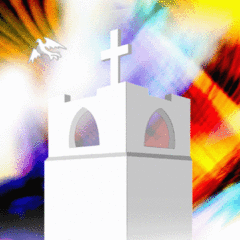There are two ways of living… One is the way of resisting Almighty God, and the other is the way of surrender to God’s eternal grace and steadfast love. Resistance to God brings anxiety and distress, restlessness and hopelessness. Surrender to God, however, brings inner peace and joy, true happiness and hope. It really is that simple.
The worldly person is always in a state of resistance and inner conflict. The spiritual person, on the other hand, has given up the struggle through their sweet surrender to God. For as St. Augustine famously stated in his autobiographical Confessions, “You have made us for yourself, O Lord, and our heart is restless until it rests in you.”
True religion, therefore, is about surrender, and a wonderful symbolic representation of this is the California condor. When it steps out off the cliff, it simply stretches wide its wings and floats in the rising air thermals. Likewise, as we yield to God’s grace through faith in Jesus Christ our Savior, we are freed to no longer flap our spiritual wings to exhaustion. Rather, by the uplifting power of God’s Holy Spirit, we are free to float weightless on God’s limitless atmosphere.
“Even youths will faint and be weary, and the young will fall exhausted; but those who wait for the Lord shall renew their strength, they shall mount up with wings like eagles [and condors], they shall run and not be weary, they shall walk and not faint.” – (Isaiah 40:30-31)
So, truly, all the weight in our hearts and minds can be tied in some way to our willful and sinful resistance to the Way and Truth and Life of God in our lives. The more you fight God, the lower you fall. The more you yield and surrender to him, the lighter you become and the higher you soar spiritually.
The Season of Lent is all about dying to our sinful rebellion, and rising up unto the abundant Life and Light and Love of our Heavenly Father. This is what our Lord Jesus meant when he declared in Luke 17:33, “Those who try to make their life secure will lose it, but those who lose their life will keep it.”
Consequently, as we move into Lent (meaning “length”) when the days lengthen toward springtime, may we ever seek to give up the fight, surrendering to the forgiveness and renewal of the Lord our God given freely to us in Christ. Moreover, may we also be ever mindful of God’s Holy Presence with us and for us in the here and now, realizing that we stand before the amazing Throne of the Eternal God each and every moment of our daily lives.
As the days lengthen and become warmer, may we come to understand more fully that the grass and flowers of the field, the trees and mountains, the rocks and rivers, Christ’s Word and Sacraments, as well as our hearts and souls, are all together the amazing Throne of God’s Presence. In reality, we stand before the Throne of God Most High now… Forever right now… So, for this Lenten Season, and for the rest of our God-given life, let us remember our most Wonder-Full Lord God every single day, the ever-present Source of all creation and salvation, in whom “we live, move and have our being” (Acts 17:28a).
Blessed Lent to All of You! Pastor Tim
